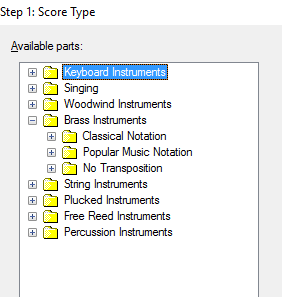Horns and trumpets
- Mar 19, 2017
Wind instrument notation...
When you are creating scores for wind instrument players via the ScoreWizard you will be offered three options for notation:

Which is the correct one?
You will select classical notation when you are writing for your trombone band. Here, all brass instruments are notated sounding. You will also choose this notation when you are an arranger who wants to work in one key only and does not want to permanently rethink. After all you can transpose single voices as needed later on.
Besides that the most common way of notation for trumpets and horns is the one called "popular music notation" here. It could as well be called "modern notation". Here, a different key is preselected for transposing instruments. The trumpets will most likely be notated a major second higher than the string instruments and the piano. So when the score is notated in C major, then the trumpet players will see D major with two sharps.
Less known is the "classical" or "old" notation. You will only find it in very ancient scores. Here, horns and trumpets are also notated in F or in B flat, but accidentals are notated in front of each note, there is no key signature.
Here you can see three different ways of notating the same example:
.png)
Clarinets, saxophones and other transposing woodwind instruments don't have to bother worrying about this question; their notation is always consistent.
More choice
In case you do not find the preferred notation, for example trombone in B flat, in the ScoreWizard, that's no disaster: You can select each desired transposition in the SystemTemplate and then enter the corresponding key in the score.
